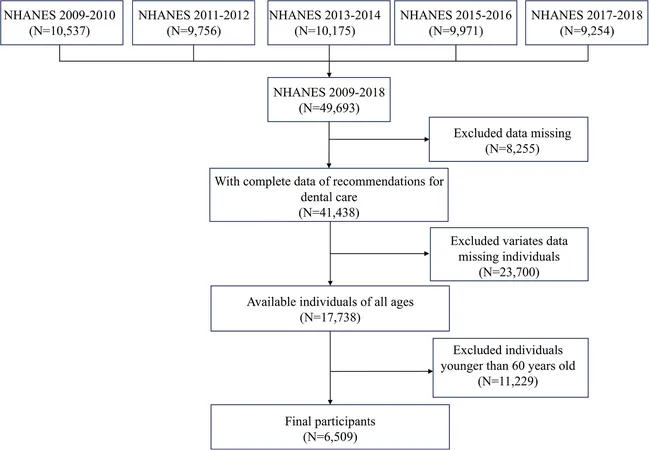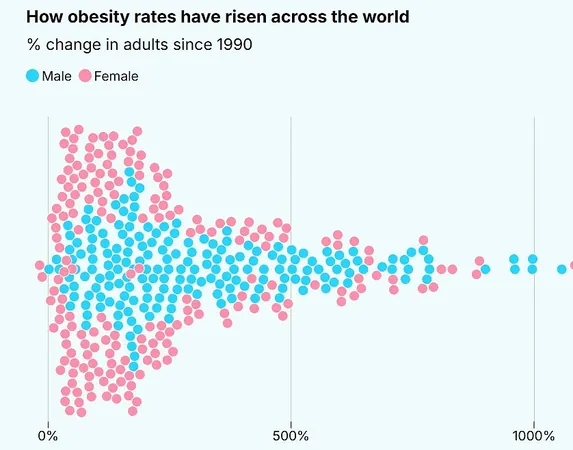
Unlocking the Secret to Better Oral Health in Seniors: The Power of Vitamin D and Physical Activity
2025-04-08
Author: Wei
Introduction
A recent study has shed light on the critical connection between vitamin D levels, physical activity, and oral care needs among older adults in the U.S. This groundbreaking research highlights how these two factors could significantly influence the dental health of seniors, paving the way for potential public health interventions.
The Research Focus
The study focused on the independent and joint effects of serum 25-hydroxyvitamin D [25(OH)D] levels and physical activity on oral care requirements in adults aged 60 and above. Utilizing data from the National Health and Nutrition Examination Survey (NHANES) conducted between 2009 and 2018, researchers analyzed the health profiles of over 6,500 older adults.
Key Findings
Results revealed that higher serum levels of 25(OH)D were linked to a lower risk of requiring oral care (Odds Ratio [OR] = 0.99). Similarly, engagement in vigorous recreational activities demonstrated a powerful protective effect, reducing the odds of oral care requirements by 30% (OR = 0.70). This suggests that older adults with sufficient vitamin D levels and an active lifestyle may significantly mitigate their oral health challenges.
Moreover, 25(OH)D appears to serve as a mediator in the relationship between vigorous exercise and oral care needs, indicating that these variables interact in promoting better oral health outcomes.
The Importance of Oral Health
Maintaining good oral health is crucial for older adults, who often face increased risks from untreated conditions such as dental caries and periodontitis. These issues can exacerbate health problems, leading to chronic pain, malnutrition, and even cognitive decline. Nearly 2.4 billion people globally are affected by untreated dental caries, and this condition's prevalence is on the rise in older populations.
Vitamin D's Role Beyond Bone Health
Vitamin D plays a vital role not only in bone metabolism but also in oral health through its impact on immune response. This nutrient enhances the function of oral immune defenses, promoting resilience against bacteria linked to gum disease. While several studies have linked low vitamin D levels to increased severity of periodontitis, the specific relationship in older adults had not been fully explored until now.
The Link with Physical Activity
Regular physical activity is another cornerstone of maintaining overall health, with profound benefits for various chronic conditions. Evidence suggests that an active lifestyle aids not only in overall well-being but can also raise plasma vitamin D levels, implicating a compelling link between physical fitness and dental health. Interestingly, existing animal studies have shown that exercise can counteract bone loss in the jaw area, which is critical for sustaining dental health in aging populations.
Implications for Public Health
As the demographic of older adults continues to grow, there is an urgent call to prioritize oral health within this group, especially since oral health problems are associated with increased healthcare costs and lower quality of life. Encouraging vitamin D supplementation and fostering physical activity could emerge as effective strategies in promoting oral health among seniors, ultimately enhancing their quality of life.
Conclusion
This research emphasizes the potent role that vitamin D and physical activity play in maintaining oral health among older adults. By integrating these elements into health promotion strategies, policymakers could potentially reduce the burden of oral diseases in aging populations and, by extension, improve their overall health outcomes. It's a reminder that maintaining good oral health is not just about dental hygiene—it's about nurturing the body holistically.
Call to Action
Is it time for a revolution in how we approach senior healthcare? With simple measures like increasing vitamin D levels and promoting physical activity, we may hold the key to unlocking better oral health and, ultimately, a healthier life for our aging population. Don’t let these insights go unnoticed! Share this with your loved ones or your community health group today!


 Brasil (PT)
Brasil (PT)
 Canada (EN)
Canada (EN)
 Chile (ES)
Chile (ES)
 Česko (CS)
Česko (CS)
 대한민국 (KO)
대한민국 (KO)
 España (ES)
España (ES)
 France (FR)
France (FR)
 Hong Kong (EN)
Hong Kong (EN)
 Italia (IT)
Italia (IT)
 日本 (JA)
日本 (JA)
 Magyarország (HU)
Magyarország (HU)
 Norge (NO)
Norge (NO)
 Polska (PL)
Polska (PL)
 Schweiz (DE)
Schweiz (DE)
 Singapore (EN)
Singapore (EN)
 Sverige (SV)
Sverige (SV)
 Suomi (FI)
Suomi (FI)
 Türkiye (TR)
Türkiye (TR)
 الإمارات العربية المتحدة (AR)
الإمارات العربية المتحدة (AR)